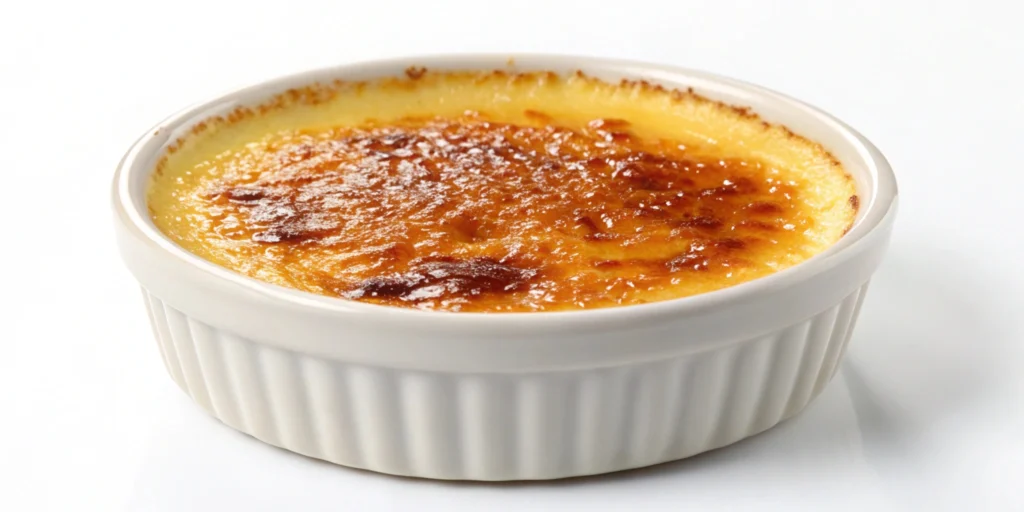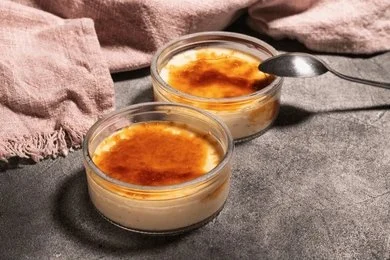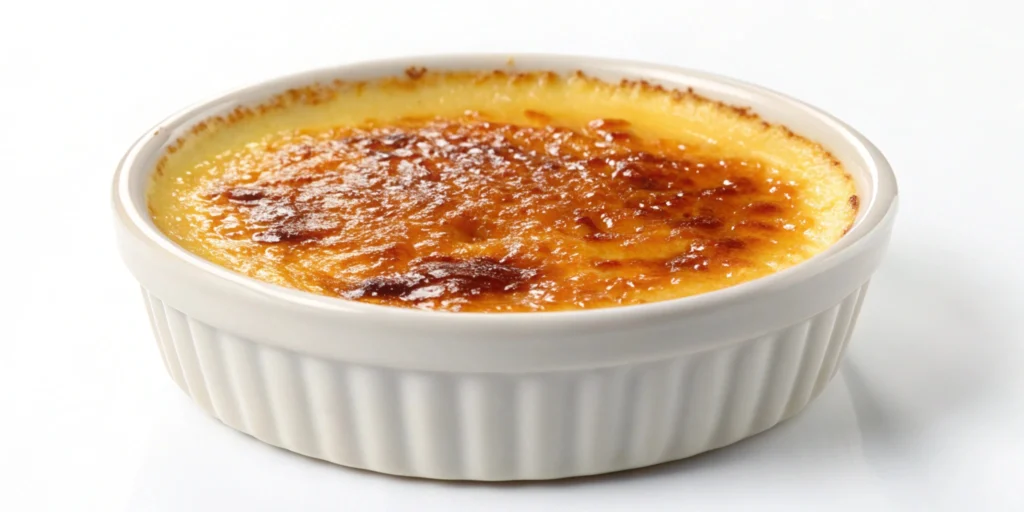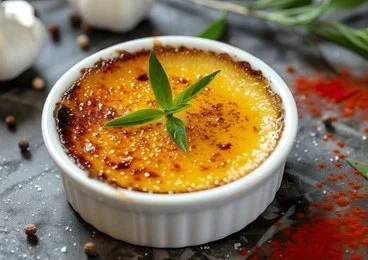Crème brûlée is one of the most cherished desserts in the culinary world—a silky custard crowned with a crisp caramelized sugar shell. It’s the perfect blend of creamy and crunchy, offering a sensory experience like no other. But have you ever wondered, “What is the secret of crème brûlée?” From its storied origins to mastering the delicate techniques required to make it, this article dives deep into the magic of this classic French dessert.
In this guide, we’ll uncover the history, essential ingredients, and step-by-step methods for making crème brûlée. Along the way, we’ll delve into common pitfalls and answer frequently asked questions to help your dessert turn out flawless every time.
The Origins and Meaning of Crème Brûlée
Historical Roots of Crème Brûlée
Crème brûlée, also known as “burnt cream,” has origins steeped in culinary tradition. Although it’s a quintessential French dessert, its roots are debated. Some culinary historians trace it back to 17th-century England, where a similar dish, known as “Trinity Cream,” emerged at Trinity College, Cambridge. Others credit Spain’s crema catalana as an earlier precursor.
What makes crème brûlée truly unique is its delicate balance between a rich custard base and the hard caramel topping. While variations of custard desserts existed across Europe, the French version became celebrated for its refinement and visual appeal.
What Does ‘Crème Brûlée’ Mean?
The name “crème brûlée” literally translates to “burnt cream.” This refers to the caramelized sugar layer that’s torched or broiled until it forms a crisp, golden crust. The burnt sugar isn’t just for show—it adds a bittersweet complexity that perfectly contrasts the dessert’s sweet, velvety custard.
How Crème Brûlée Became a Global Dessert Favorite
By the 1980s, crème brûlée had secured its spot as a menu staple in fine dining restaurants worldwide. Its resurgence was partly due to its visual appeal and the dramatic act of torching the sugar table-side, which diners found captivating.
Today, this dessert continues to inspire chefs and home bakers alike. While the traditional vanilla version remains a favorite, adventurous cooks have introduced creative flavors, from lavender to espresso, expanding its legacy even further.

The Essential Ingredients in Crème Brûlée
The Role of Heavy Cream and Egg Yolks
When it comes to crafting a perfect crème brûlée, the foundation lies in its essential ingredients. The creamy base owes its luscious texture to heavy cream, which provides a rich, smooth consistency. Egg yolks, on the other hand, are the magical binding agents that give the custard its velvety structure. Together, they form a harmonious blend that sets beautifully when baked.
To achieve the right balance, it’s crucial to use fresh, high-quality cream and yolks. The ratio is key—too many yolks can result in an overly dense custard, while too few leave it runny. If you’ve ever wondered, “What is the secret of crème brûlée?”, the answer partly lies in this careful balance.
Choosing Vanilla: Beans vs. Extract
Vanilla is the soul of classic crème brûlée. Whether you choose real vanilla beans or high-quality extract, the choice impacts flavor profoundly. Vanilla beans provide a natural, aromatic intensity and add beautiful black specks to the custard. However, a premium vanilla extract can also work wonders in capturing the essence of this classic flavor.
For a unique twist, consider experimenting with other infusions like cinnamon sticks, espresso, or even lavender. The secret to perfect flavor lies in how these elements are steeped in the cream before being combined with the egg yolks.
Importance of Sugar and Salt in Flavor Balance
While sugar sweetens the dessert, a small pinch of salt enhances its complexity. The caramelized sugar topping offers the perfect contrast to the custard’s sweetness, making every bite a delightful experience. Don’t skip the salt—it’s one of the secrets that transforms good crème brûlée into extraordinary.
Mastering the Technique: The True Secret of Crème Brûlée
The Art of Tempering Egg Yolks
Tempering is a critical technique in crème brûlée preparation. It involves gradually combining hot cream with whisked egg yolks to prevent curdling. This step ensures a silky-smooth custard without lumps or scrambled eggs. When whisking the yolks, add the heated cream in a slow stream while stirring constantly. This gentle process is, without a doubt, a cornerstone of “What is the secret of crème brûlée?”
Perfecting the Water Bath Baking Technique
Baking the custard in a water bath, or bain-marie, is another vital technique. The water bath helps distribute heat evenly, preventing the custard from overcooking. To set this up, place your ramekins in a deep baking dish, then pour hot water around them until it reaches halfway up the sides. Bake at a low temperature (about 300°F) until the custard jiggles slightly when shaken.
Pro tip: Line the bottom of the baking dish with a kitchen towel to prevent the ramekins from sliding and to minimize splashes. This method is one of the secrets to achieving a creamy texture without cracks.
How to Achieve a Silky-Smooth Custard Texture
The secret to that luxurious, melt-in-your-mouth texture lies in three factors: using fresh ingredients, chilling the custard overnight, and baking slowly. Chilling the custard mix before baking allows the flavors to meld and ensures consistent cooking. Once baked, refrigerate it uncovered to prevent condensation.
Remember, crème brûlée is as much about patience as precision. Rushing through these steps can result in a grainy or overcooked custard. By following these techniques, you’ll discover the true secret to this timeless dessert.

The Brûlée: Achieving the Perfect Caramelized Top
Tools for Torching: Torch vs. Broiler
The signature brûlée layer is what sets this dessert apart, giving it its name and irresistible texture. To achieve that golden, caramelized crust, a handheld torch is the go-to tool. It provides precision and allows you to control the heat for even caramelization. If you don’t have a torch, don’t worry—a broiler can do the job too. Simply place the custards under the broiler and watch closely to avoid burning the sugar.
However, the handheld torch remains the preferred choice for many chefs and home cooks. It’s efficient, easy to use, and delivers consistent results. For a detailed guide on brûlée tools, check out this crème brûlée cheesecake recipe for more insights into mastering caramelization.
Tips to Avoid Over-Caramelization
Caramelizing sugar is an art. Too much heat or leaving the flame on one spot can lead to a bitter, burnt layer. Start by sprinkling an even layer of granulated sugar on the custard and use quick, circular motions with the torch. Keep the flame about 2 inches away from the surface to melt the sugar gradually.
If you’re wondering, “What is the secret of crème brûlée?”, nailing the caramelized top is a big part of it. The sugar layer should be thin but firm enough to crack with a spoon, revealing the creamy custard beneath.
How to Create a Thin, Crispy Sugar Shell
The key to a perfect sugar shell lies in even distribution. After sprinkling sugar, gently tilt the ramekin to ensure an even coating. Tap off excess sugar to avoid clumps. For added depth, you can torch a second layer of sugar after the first one cools. This step creates a thicker, crunchier crust while keeping the custard below cool and creamy.
Variations and Modern Twists on Crème Brûlée
Flavor Variations: From Coffee to Citrus
While traditional vanilla crème brûlée reigns supreme, modern twists have given this dessert a new life. Coffee-infused custard provides a bold and robust flavor, while citrus variations like orange or lemon zest add a refreshing tang. For an exotic twist, try steeping lavender or cardamom in the cream.
These variations not only enhance the flavor but also answer a common question: “What is the secret of crème brûlée?” The secret lies in its versatility. With a few tweaks, you can customize this dessert to suit any palate.
Innovative Presentations: Jars, Pies, and More
Crème brûlée isn’t confined to ramekins anymore. Chefs are serving it in mini mason jars, tart shells, and even layered as part of a cake. These creative presentations elevate the dessert while maintaining its classic charm. For example, combining crème brûlée with cheesecake creates a dessert that’s both decadent and visually stunning.
Explore more creative ideas, like pairing crème brûlée with chocolate or fruit-based desserts, in this guide on what makes crème brûlée special.
Vegan and Low-Sugar Alternatives
For those with dietary restrictions, vegan and low-sugar versions are a game-changer. Coconut milk and almond milk serve as excellent substitutes for cream, while natural sweeteners like stevia or monk fruit replace sugar. These alternatives allow everyone to enjoy the magic of crème brûlée without compromising on taste.
Troubleshooting Common Crème Brûlée Issues
Why Did My Custard Not Set?
One of the most frustrating problems when making crème brûlée is a custard that doesn’t set properly. This can happen if the custard wasn’t baked long enough or the oven temperature was too low. To avoid this, always bake the custards in a water bath at 300°F until the centers are just slightly jiggly. Using an instant-read thermometer is helpful—the ideal internal temperature is 165°F.
If you’re asking yourself, “What is the secret of crème brûlée?”, precision and patience are key. Baking the custard slowly allows it to set evenly without curdling.
How to Fix a Burnt Sugar Layer
A burnt sugar topping can ruin an otherwise perfect crème brûlée. To prevent this, keep the flame of your torch moving in small, circular motions and avoid staying in one spot for too long. If using a broiler, place the custards at least 6 inches away from the heat and watch carefully.
If your topping still burns, don’t worry—it happens to the best of us. Gently scrape off the sugar layer and try again with a fresh sprinkle of sugar.
Avoiding a Grainy Texture in Custard
Grainy custard is often the result of overcooking or rushing the tempering process. Be sure to add the hot cream to the yolks slowly while whisking constantly. Following this step ensures a silky-smooth texture every time.

FAQs About Crème Brûlée
How Do I Know When Crème Brûlée is Done?
The custard is done when it jiggles slightly in the center but doesn’t slosh. A visual cue works well, but using a thermometer to check for an internal temperature of 165°F guarantees perfect results.
Can I Make Crème Brûlée Without a Torch?
Yes, you can! A broiler is a great alternative for caramelizing the sugar topping. Simply place the ramekins under the broiler for a few minutes, keeping a close eye to avoid burning.
What’s the Difference Between Crème Brûlée and Crème Caramel?
While both are custard-based desserts, crème brûlée has a crisp caramelized sugar topping, whereas crème caramel features a soft caramel sauce. Each has its own charm, but the brûlée’s crunchy sugar layer often steals the show.
Conclusion
Crème brûlée is more than just a dessert—it’s a timeless masterpiece that combines simplicity with elegance. From its velvety custard base to its crisp caramelized sugar topping, every element plays a vital role in creating its magic. If you’ve ever asked, “What is the secret of crème brûlée?”, it lies in the details: using high-quality ingredients, mastering tempering techniques, baking with precision, and achieving that perfect sugar crust.
Whether you stick to the traditional vanilla flavor or explore modern twists like coffee, citrus, or vegan alternatives, crème brûlée offers endless possibilities to delight your palate. With patience, practice, and a touch of creativity, you can create this classic French dessert and enjoy its irresistible charm.
So why not grab your ramekins and torch and give it a try? With the secrets revealed in this guide, you’re well on your way to mastering the art of crème brûlée!
For more tips and tricks, check out other dessert recipes on Kamala Recipes.

